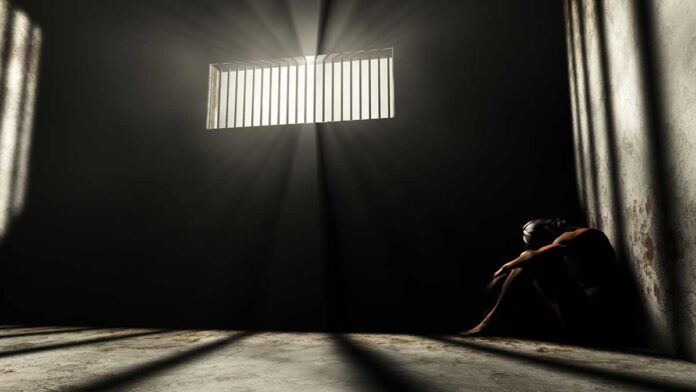This is part three of a series on LGBTQ people in prison. Unless otherwise noted, names have been altered to protect the privacy of formerly incarcerated persons.
Evie Litwok tells a chilling story of when she was held in solitary confinement over 42 days during her time in prison in both West Virginia and Florida.
“Women were committing suicide,” she said. “You could hear them taking their sheets and hanging themselves.”
Litwok, Founder and Executive Director of Witness to Mass Incarceration, a prisoner advocacy group for women and LGBTQ people, said that there is no reporting on the number of suicides and attempted suicides in women’s prisons — something she wants addressed.
In the U.S., suicide is the leading cause of death among incarcerated persons, accounting for more than half of all deaths occurring during incarceration. It is higher for women than men, and it is highest among LBT women, according to a March 2021 report in the Journal of Correctional Health Care.
According to the National Institute of Mental Health in 2020, the rate of suicide for women in the general population was 6.0 per 100,000 individuals. The suicide rate increases to 11 per 100,000 for women in federal prisons and elevates to 28 per 100,000 for women in local jail facilities.
Disproportionality begins for LBT women at the prison door. While only 3.4 percent of the population are estimated to be lesbian or bisexual, those who self-identify as lesbian or bisexual comprise 35.7 percent of jails and 42.1 percent of prisons.
Trans and nonbinary prisoners are often isolated and targeted. A 2020 study by Penal Reform International was succinct: “By using the gender binary to make housing decisions [within the prison estate], a ‘double punishment’ is enacted on transgender people by making their bodies hyper-visible, and thus more susceptible to violence.”
That solitary confinement can lead to suicidality is well-known in the corrections field. Yet it is used as punishment most often against LGBTQ prisoners as detailed in the “Policy Review and Development Guide on LGBTI Persons in Custodial Settings” from the U.S. Department of Justice National Institute of Corrections.
Jay Morales attempted suicide while incarcerated at the State Correctional Facility at Muncy. Morales, who identifies as trans masculine and nonbinary, found their stay at Muncy “like being buried alive. I wanted to die every day I was there.”
Morales points to isolation from other inmates, harassment by staff, denial of health and mental health services and lack of access to visitation due to how far Muncy is from Philadelphia as contributing factors to a growing sense of despair when she was first incarcerated.
But it was a stint in solitary — punishment she says was meted out for how she was dressed for a religious service at the prison — that led to her suicide attempt. Morales says they feel grateful to have survived, but “I wasn’t sure I would make it. It was total hell.”
Like many gender variant, gender nonconforming, nonbinary and trans people in jails and prisons, Morales faced severe abuse that included verbal and sexual harassment as well as physical and sexual violence from both inmates and staff.
And like too many gender nonconforming people, it was Morales’s gender identity that made them a target for law enforcement starting as a teen. At their high school, Morales’s masculine identity and affect “took me into a lot of fights,” they said. “It was a lot, all the time.”
Other students would challenge Morales about their sexuality and gender identity with name-calling and other harassment. Morales was often followed off school property and assaulted. “I just finally had enough. I left.”
But with no high school diploma, getting a job was difficult and conflicts at home escalated. Morales landed on the street at 16, in the criminal justice system at 18 and attempting suicide at 19.
According to the Vera Institute of Justice, “Transgender youth are more likely to leave school due to harassment, physical assault, and sexual violence; experience homelessness; and suffer verbal and physical abuse in a range of public spaces, including crisis centers and shelters. These transphobic experiences often lead to transgender people being excluded from formal economies.”
Vera adds, “As a result, they are more likely to commit crimes of survival like prostitution, involvement in the drug trade, or violent acts of self-defense. These crimes, in turn, lead to increased police stops and arrests for transgender people.”
This was Morales’s story, and they are far from anomalous: 16 percent of trans-identified adults have been incarcerated, compared to 2.7 percent of cisgender adults, according to the American Journal of Preventive Medicine.
Layleen Cubilette-Polanco, an Afro-Latinx trans woman, was one of those people who didn’t make it out. Cubilette-Polanco, 27, died in solitary confinement June 7, 2019 at the Rose M. Singer Center jail on Rikers Island. The medical examiner’s report says Cubilette-Polanco died after an epileptic seizure.
Cubilette-Polanco was in jail — from April 2019 until her death two months later — because she could not afford the $500 cash bail for a sex-worker charge. She was in solitary confinement, despite her history of seizures, because she had been sentenced to 20 days of solitary for an altercation with another person in the Transgender Housing Unit dormitory.
During the investigation into her death, video was released showing that guards waited 90 minutes before getting help for Cubilette-Polanco. Guards were seen laughing over the unresponsive woman in the video.
The National Center for Lesbian Rights (NCLR) is a non-profit, public interest law firm that advocates for equitable public policies affecting the LGBTQ community.
As part of their mission, NCLR works at the local, state and federal levels to ensure that LGBTQ prisoners are as safely housed as possible and have access to life-saving medical care.
NCLR notes, “LGBTQ people housed in prisons and jails face dire problems related to their sexuality and gender identity. They are often placed in segregated housing ‘for their own protection,’ which deprives them of jobs, education, and other programming that could shorten their sentences and better prepare them for release.”
NCLR details the problems of solitary confinement that Litwok and Morales bore witness to and that killed Cubilette-Polanco. “When prisoners are placed in solitary confinement, they typically spend 23 hours a day alone in their cells with only an hour to exercise or bathe (also alone). Solitary confinement is extremely dangerous to prisoners’ mental health. Transgender prisoners also encounter serious problems obtaining hormones and other medical care, and are at extreme risk of being sexually assaulted by staff or other inmates.”
That is what the lawsuit brought by Jules Williams on November 6 asserts. Williams, 37, has lived openly as a woman since she was a teen and began hormone treatments at 18. Both her birth certificate and her state identification list her gender as female. Court documents detail gender-confirming surgeries she had in 2008.
Yet despite these facts and having requested protective custody in a single jail cell, Williams was housed at the Allegheny County Jail (ACJ) in a double cell with a male inmate. That placement led to her being raped by that inmate repeatedly over a period of four days.
The ACLU of Pennsylvania and the Law Offices of Timothy P. O’Brien have filed a lawsuit against Allegheny County on behalf of Williams who asserts she was violently assaulted while she was incarcerated at the ACJ. The lawsuit contends that Williams endured “sexual, physical, and verbal abuse” during incarcerations at ACJ between 2015 and 2017.
The ACLU states, “Along with the sexual assaults in 2015, Williams was also verbally harassed by jail staff and inmates, with insults that include ‘s/him,’ ‘faggot,’ and ‘freak show.’ While incarcerated, ACJ staff denied her requests to be housed with other female inmates and forced her to shower in the presence of male guards and inmates.”
Williams is no longer incarcerated.
“The Allegheny County Jail’s practice demonstrates a callous disregard for human safety and dignity,” said Alec Wright of the Law Offices of Timothy P. O’Brien, who is representing Williams. “The warden and other supervisors at the jail are aware that this practice causes severe physical and emotional harm to transgender women at the jail, but they refuse to change it. The jail’s practice is quite simply unconstitutional and cannot stand in modern society.”
The civil rights complaint seeks both compensatory and punitive damages.
A different instance of a rape of a trans woman inmate at AJC who was forced to share a cell with a male inmate was reported in 2018. In that case the accused rapist, Taylor Booth, 21, was charged. The victim was not named.
Litwok said, “Sexual violence in confinement hits the LGBT community the worst, and it’s not a subject we talk about enough.”
She adds, “We are disproportionately abused in prisons, jails and detention centers.”
NCLR asserts, “We will continue to work with local, state, and federal officials to ensure that LGBTQ prisoners are as safe as possible, that transgender prisoners are housed in accordance with their gender identity and that LGBTQ prisoners have access to proper medical care.”
A dozen years after their suicide attempt, and finally free of both prison and probation, Morales now works as a counselor with a youth outreach program in New Jersey, trying hard, they said, to keep teens like they were from entering the criminal justice system.
Morales says of their own experience, “I barely made it out. So many others don’t. You never stop thinking about that part. Not really. We have to do more for our people inside. We just have to.”
For more information visit Witness to Mass Incarceration, NCLR, and the ACLU PA on the web.

